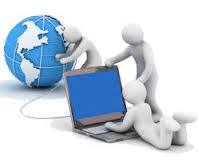By Nicholas
Click on the pictures or diagrams to expand them.
In business, there are various uses of ICT. These include administration, production, security, marketing, research and communication. Different business use various ICT related procedures to perform their day to day tasks. Examples include generating reports, distributing information and talking to clients.
A range of office software programmes are used to improve business performance. Some of these are word processing packages, databases to hold human resource records, stock details and so on, and the use of spreadsheet packages for statistical record keeping and analysis.
The finance director has access to accounts software that monitors revenue and costs and generates reports on the current financial status as well as historical data to enhance data analysis and inform decision making.
Bar coding is used extensively and provides a quick and accurate method of identifying raw materials, individual meals, cases of product and pallets of stock.

Businesses may use ICT to increase productivity and growth. They might invest in ICT infrastructure to streamline processes, or use e-commerce to expand into international markets.
In 2008, New Zealand had a lower percentage of businesses with broadband access compared with Australia. However, businesses in New Zealand were more likely to have a website and were more likely to place and receive orders over the Internet.
In both New Zealand and Australia, more than 90 percent of businesses had broadband access (91 percent in New Zealand and 96 percent in Australia). Sixty percent of New Zealand businesses had a website compared with 53 percent in Australia.
New Zealand businesses were more likely to use the Internet to receive and place orders than businesses in Australia. In New Zealand, 64 percent of businesses used the Internet to place orders (compared with 53 percent in Australia) and 42 percent used the Internet to receive orders (compared with 29 percent in Australia).
The Internet has dramatically changed the way government, businesses, and individuals operate. High-speed Internet is seen as an enabler of international connectivity. This is important for a geographically isolated country such as New Zealand. High-speed Internet provides New Zealanders with access to international markets, new ideas and knowledge. These are key drivers of innovation, productivity, and economic growth.
Digital subscriber line (DSL) was the most common non-analog connection technology in both countries. Of non-analog users in New Zealand, 77 percent used DSL compared with 57 percent in Australia. This difference can be partly explained by the rapid growth of mobile wireless connections in Australia, from 1.3 million in December 2008 to 2 million in June 2009. Mobile wireless connections made up over half of the other non-analog connections in Australia at June 2009.
Fibre optic links are becoming more prevalent. At present the speeds offered aren’t much better than DSL.
Conclusion
The supply and use of ICT in New Zealand and Australia is similar. Figures for the total sales of ICT commodities expressed as a percentage of GDP were similar (9.9 percent in New Zealand and 9.3 percent in Australia). A high proportion of businesses used broadband to access the Internet (91 percent in New Zealand and 96 percent in Australia). More than half of all broadband users in both countries had speeds of 1.5Mbps or greater.

ICT can definitely help give businesses a cutting edge, now and in the future. ICT will improve it’s performance in the future too, plus become even more cost effective.
For more blogs please go to www.NicksDigitalSolutions.com and choose Nicks blog.
For E-Learning material, please go to www.NicksDigitalSolutions.com and choose E-Learning Shop and, in particular, the Business option.
Nicholas (Nick Thorne) is the founder of Nick’s Digital Solutions Limited a company that specialises in Education and Training; ICT Consultancy; Infopreneur; Project and Analysis; and Writing. He lives in Levin, Horowhenua District, New Zealand.
